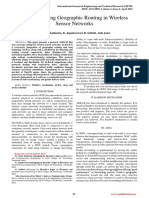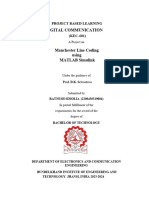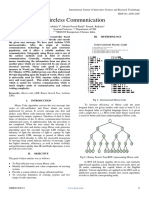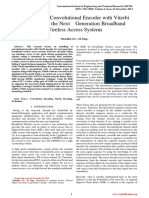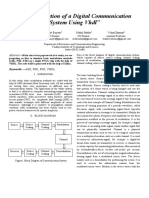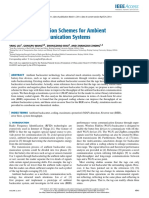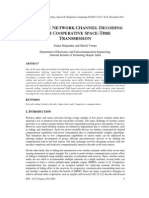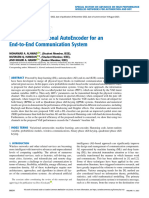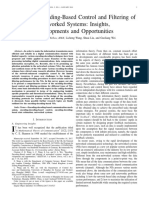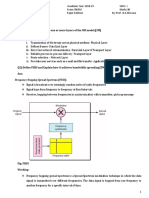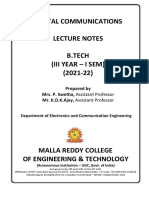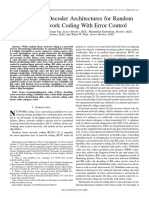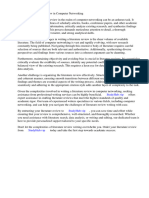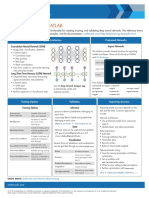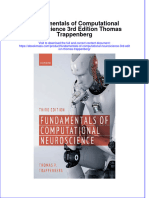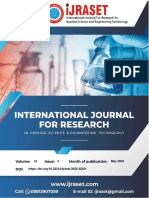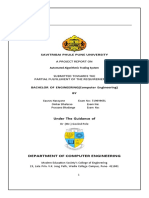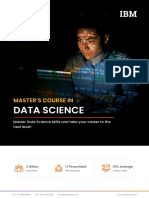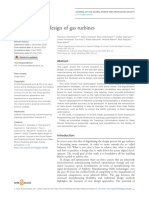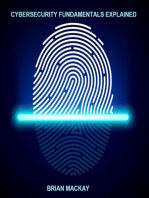Professional Documents
Culture Documents
Autoencoders Based Digital Communication Systems
Copyright
Available Formats
Share this document
Did you find this document useful?
Is this content inappropriate?
Report this DocumentCopyright:
Available Formats
Autoencoders Based Digital Communication Systems
Copyright:
Available Formats
Volume 9, Issue 1, January – 2024 International Journal of Innovative Science and Research Technology
ISSN No:-2456-2165
Autoencoders Based Digital
Communication Systems
Anjana P K (Student)1 Ameenudeen P E (Assistant Professor)2
Department of ECE College of Engineering Trivandrum Department of ECE College of Engineering Trivandrum
Trivandrum, India Trivandrum, India
Abstract:- To demonstrate over the air transmission, it is been deeply optimised over the past centuries, and it appears
essential to frame, alternate and execute a transmission challenging to compare with them in terms of efficiency, we
systems repressed by neural networks. Autoencoders are are drawn to the conceptual simplification of a transmission
used to train the entire system composed of transmitters network which is to be trained to broadcast over any kind of
and receivers. Estab- lishing a vital novel style of medium with no prior arithmetical modelling and analysis.
thinking regarding communications network design as a
point to point regeneration task that seeks to optimise Tx A DNN that has been programmed to recreate the
and Rx systems into a single process by interpreting a source at the output is referred to as an autoencoder.
transmission system as an autoencoder is performed. Because data should transit through each level, the system
In this, several autoencoders such as deep encoder, should discover a strong depiction of the input signal at each
convolutional autoencoder and a simplest possible level. An auto- encoder is a form of ANN that uses
autoencoder is simulated in Python. Lastly, BLER machine algorithms to develop optimum encoding of
versus Eb/N0 for the (2,2) and (7,4) autoencoder is untrained input. By trying to recreate the data by
plotted. encryption, the code is checked and enhanced. By
instructing the network to disregard inconse- quential
Keywords:- Autoencoder, Deep Learning, End-to-End input (”noise/interference”), the autoencoder creates a
Communication. pattern for a set of information generally for feature
extraction. In this paper, section II describes the autoencoder
I. INTRODUCTION concept, section III gives an explanation of how the
autoencoder is simulated, section IV presents the result
The basic issue of communication involves and finally the conclusion in section V.
”replicating at one end either exactly or almost a signal
selected at some other end”, or, reliably conveying a II. AUTOENCODER CONCEPT
message from a source to a recipient over a medium using
a Tx and a Rx [1]. To obtain a theoretically ideal A channel autoencoder is depicted in Fig. 1. A one-hot
clarification to the given problem in practise, Tx and Rx are vector represents the input symbol. Tx includes multiple
often separated into many computa- tional units, each of thick layers of a FNN. For every encoded input symbol, last
which is dedicated for a certain sub-task, like encoding, thick layer has modified to obtain two values of output that
channel coding, modulating, and equalisation. Despite the depict complex numbers containing real part and an
fact that such an architecture is considered to be suboptimal. imaginary part. The physical terms on x is decided by
It offers the benefit of allowing each element to be normalization layer. An AWGN with an immobile variance
separately studied and tuned, resulting in today’s highly depicts the channel. Here Eb/N0 represents energy (Eb) to
effective and reliable systems. DL routing algorithms, on the noise power spectral density (N0) ratio. The Rx was used as
other hand, return to the basic formulation of the breakdown FNN. Softmax activation is used in the last layer. Every
in communication and strive to optimise transmitter and training instance has a different noise value. In the forward
receiver together without the need for any arbitrarily added pass, a noise layer is used to alter the given signal. It is
block structure. Even though today’s schemes have now rejected by the rearward pass.
Fig 1 Autoencoder Representation
IJISRT24JAN1828 www.ijisrt.com 1719
Volume 9, Issue 1, January – 2024 International Journal of Innovative Science and Research Technology
ISSN No:-2456-2165
DL (also referred to as structured learning) is a ML ap- III. END TO END LEARNING OF CODED
proach that relies on ANNs and reinforcement learning. SYSTEMS
Learn- ing can be supervised, semi supervised, or not
supervised. We evaluate the effectiveness of an autoencoder to
end- to-end communication to that of traditional data
Deep Learning transmission using channel coding. A traditional data
ML (particularly DL) serves strong self-operating transmission is com- posed of many pieces for channel
meth- ods in transmission setups for understanding the encoding or decoding, as well as modulation or
information available in the spectra and adjust to movements demodulation. An autoencoder based approach lacks such
within the spectra in order to achieve the duty stated in this explicit blocks, meanwhile attempting to enhance the
ideology. Wireless communication is a combination of a system from end-to-end while conforming to structure
variety of waveforms, channels, congestions, and characteristics. We examine the performance of autoencoder
interference effects, each with an individual complicated models that are analogous to standard channel coded
structure that changes rapidly. Because of the distributed communications systems over the AWGN channel using
character of air transmission channels, data within the these system characteristics.
wireless communications obtain higher magnitude as well as
greater pace and faces through intervention along with many System Model
other safety hazards. Conven- tional designs and ML tactics To reduce complexity during processing, the blocks are
frequently fail to capture the feeble relation among greatly split into different stages. Coding rate, R = K/N, where N
distributed information spectra and transmission models, repre- sents the output size after channel encoding and
whereas DL develops a possible method of satisfying transmitter, information block of size K bits is fed to
wireless communication system data rate, speed, channel encoder where a block of size N is output after
dependency, and security needs. One motivating example channel encoding and the N. Then the data block is fed to
comes from classifying signals, where a receiver must the modulator of order Mmod where the data bits are
distinguish signals received based on features of the divided into codewords of size kmod = log2(Mmod), and
waveform, such as modulation done at the transmitter that each codeword is mapped to a point in the signal
adds the carrying signal’s data via variation of its constellation with given amplitudes for the I,Q signals. At
parameters. the receiver, the reverse process of the above happens where
incoming symbols are mapped to codewords and the
End To End Communication codewords are grouped serially to produce the block. It is
Enhanced DNNs are used for transmitting and then fed to the channel decoder where the N bit sized block
receiving in a start-to-finish setup for communication. is converted to K bit sized block after channel decoding
However, the un- known CSI prevents the start-to-finish which is the estimation of the transmitted information block.
setup without knowing by blocking the backward
propagation of errors, which are used for tutoring the
weights of DNNs.
Fig 2 A Standard Communications System Setup made up of Encoding and Decoding Blocks
IJISRT24JAN1828 www.ijisrt.com 1720
Volume 9, Issue 1, January – 2024 International Journal of Innovative Science and Research Technology
ISSN No:-2456-2165
IV. RESULTS
A simplest possible autoencoder is shown in Fig. 3.
The autoencoder is trained for 50 epochs. Autoencoder may
reach upto a value of validation loss of around 0.09. The
first row is the input and second row is the output. When
looking to the output, a little bit of input is loss with this
basic approach.
Fig 6 Grey Scale Image
Fig 3 Simple Autoencoder
A deep autoencoder is shown in Fig. 4. The
autoencoder is trained for 100 epochs. A loss of test near to
0.10 and train loss of nearly 0.11 is obtained. Autoencoder
may reach upto a value of validation loss of around 0.01 Fig 7 Noisy Image
(Difference between train loss and test loss). The first row is
the input and second row is the output. The output is pretty
similar to that of input when using deep autoencoder.
Fig 8 Denoised Output
Fig 4 Deep Autoencoder For an autoencodder in an end-to-end communication
sys- tem, it attempts to learn representations x of the
A convolutional autoencoder is depicted in Fig. 5. It messages s that are resilient to channel impairments
makes sense when using convolutional neural network since mapping x to y (e.g., noise, fading, distortion, and so on),
the inputs are images. Conv2D and MaxPooling2D layers are such that the delivered message may be retrieved with a low
there in the encoder, whereas there is Conv2D and likelihood of a mistake. In other words, while conventional
UpSampling2D layers in the decoding section. These autoencoders remove redundancy from input data in order to
representations are 8x4x4, so we modify them to 4x32 in compress it, this autoencoder (the ”channel autoencoder”)
such a way that it is able to display them as grayscale frequently adds redundancy, learning an intermediate
images as in Fig. 6. representation that is resistant to channel perturbations [2].
For image denoising, here, a convolutional Figure 9 depicts the learned images x of messages
autoencoder is used. Compared to the previous when (n, k) equals (2,2) as complex constellation
convolutional autoen- coder(Fig. 5), to increase the coordinates, where the x and y axes correlate to the initial
performance of the regenerated output, we will use a small and next transmitted signal correspondingly. Fig. 10 and fig.
different model with high number of filters per each layer. 11 depict a similar comparison, but this time for a (2,2) and
The autoencoder is trained for 100 epochs. A noisy image is (7,4) communications network. Interestingly, when the
obtained as in Fig. 7 and the denoised output is displayed in autoencoder obtains relatively similar BLER as unencrypted
Fig. 8. That is, an autoencoder is used to regenerate the input BPSK for (2,2), it exceeds it for (7,4) over the whole Eb/N0
at its output without any prior knowledge. Image denoising range. This suggests that it has learned some type of
is one of the greatest requirements in the image processing combined coding and modulation strategy that results in
field. coding gain. This solution must be evaluated to a
significantly greater modulation technique em- ploying a
channel code (or the optimum sphere packed in eight
dimensions) for a genuinely fair comparison. A quality mea-
surement comparison for multi-channel types and
parameters (n, k) with varied baselines is beyond the scope
of this work and will have to wait for future research. BER
Performance.
Fig 5 Convolutional Autoencoder
IJISRT24JAN1828 www.ijisrt.com 1721
Volume 9, Issue 1, January – 2024 International Journal of Innovative Science and Research Technology
ISSN No:-2456-2165
Figures 12-14 show simulated BER performances of
different autoencoder models with R = 1/2, 1/3, 1/4 and their
baseline systems with convolutional coding with respective
code rates and BPSK modulation scheme. The selected
block length for baseline system is K = 800 and the
constraint length of the convolutional encoder/decoder is
taken as 7. It can be observed that the BER performance of
the autoencoder improves when message size is increasing.
For a given code rate, M = 2 model has almost the same
performance with uncoded BPSK while M = 256 model
has resulted in a much improved BER performance
closer to the baseline. This improvement is achieved since
the model has more degrees of freedom and more flexibility
for a better end-to-end optimization when the message size
is high.
Fig 9 Constellation Produced by (2,2) Autoencoder
Fig 12 R=1/2 Systems
Fig 10 BLER vs Eb/No for (2,2) Autoencoder
Fig 11 BLER vs Eb/No for (7,4) autoencoder Fig 13 R=1/3 System
IJISRT24JAN1828 www.ijisrt.com 1722
Volume 9, Issue 1, January – 2024 International Journal of Innovative Science and Research Technology
ISSN No:-2456-2165
[5]. S. Do¨rner, S. Cammerer, J. Hoydis, and S. t. Brink,
“Deep learning based communication over the air,”
IEEE Journal of Selected Topics in Signal
Processing, vol. 12, no. 1, pp. 132–143, 2018.
[6]. D. Silver et al., “Mastering the game of go with deep
neural networks and tree search,” Nature, vol. 529,
no. 7587, pp. 484–489, 2016.
[7]. M. Zorzi, A. Zanella, A. Testolin, M. D. F. De
Grazia, and M. Zorzi, “Cognition-based networks:
A new perspective on network optimization using
learning and distributed intelligence,” IEEE Access,
vol. 3, pp. 1512– 1530, 2015.
[8]. M. Abadi et al., “TensorFlow: Large-scale machine
learning on het- erogeneous distributed systems,”
arXiv:1603.04467, 2016. [Online]. Available:
http://tensorflow.org/
[9]. Y.-S. Jeon, S.-N. Hong, and N. Lee, “Blind detection
for MIMO sys- tems with low-resolution ADCs
using supervised learning,” IEEE Int. Conf.
Fig 14 R=1/4 System Commun., May 2016, pp. 1–6, doi:
10.1109/ICC.2017.7997434.
V. CONCLUSION [10]. M. Abadi and D. G. Andersen, “Learning to protect
communications with adversarial neural
Autoencoders are widely used in communication as cryptography,” arXiv:1610.06918, 2016.
well as for image denoising. The concept of autoencoders [11]. I. Goodfellow, Y. Bengio, and A. Courville, Deep
helps to simplify the entire communication system. By the Learning. Cam- bridge, MA, USA: MIT Press, 2016.
invention of autoencoders, programs can be made easily [12]. T. J. O’Shea, J. Corgan, and T. C. Clancy,
without any prior knowledge. Various autoencoders are built “Unsupervised representation learning of structured
in Python and is compared the same with the efficiency radio communication signals,” in Proc. IEEE Int.
while using hamming codes. Various applications to DL in Workshop Sensing, Processing and Learning for
the physical layer is seen in this project. BER comparison of Intelligent Machines (SPLINE), 2016, pp. 1–5.
different autoencoders of R=1/2, 1/3, 1/4 with M=2, 4, 16, [13]. R. Al-Rfou, G. Alain, A. Almahairi et al., “Theano:
256 is observed. A key question is how we can run a A Python framework for fast computation of
structure for an arbitrary medium such that the channel mathematical expressions,” arXiv preprint
model is unknown. Furthermore, it is critical to enable on- arXiv:1605.02688, 2016.
the-fly finetuning in order to adjust the system to shifting [14]. D. George and E. Huerta, “Deep neural networks to
channel circumstances for which it was not previously enable real-time multimessenger astrophysics,”
trained. Another critical challenge is determining how to arXiv preprint arXiv:1701.00008, 2016.
increase the block size in order to improve the autoencoder’s [15]. D. Maclaurin, D. Duvenaud, and R. P. Adams,
efficiency. Overcoming the limitation, we believe some “Gradient-based hy- perparameter optimization
changes can be implemented in the coming phase. through reversible learning,” in Proc. 32nd Int.Conf.
Mach. Learn. (ICML), 2015.
REFERENCES [16]. J. Qadir, K.-L. A. Yau, M. A. Imran, Q. Ni, and A.
V. Vasilakos, “IEEE Access Special Section
[1]. S. Do¨rner, S. Cammerer, J. Hoydis and S. t. Brink, Editorial: Artificial Intelligence Enabled
”Deep Learning Based Communication Over the Networking,” IEEE Access, vol. 3, pp. 3079–3082,
Air,” in IEEE Journal of Selected Topics in Signal 2015.
Processing, vol. 12, no. 1, pp. 132-143, Feb. 2018, [17]. Portilla, Javier, et al. ”Image denoising using scale
doi: 10.1109/JSTSP.2017.2784180. mixtures of Gaus- sians in the wavelet domain.”
[2]. O’shea, T., Hoydis, J. (2017). An introduction to IEEE Transactions on Image processing 12.11
deep learning for the physical layer. IEEE (2003): 1338-1351.
Transactions on Cognitive Communications and [18]. Vincent, Pascal, et al. ”Extracting and composing
Networking, 3(4), 563-575. robust features with denoising autoencoders.”
[3]. F. A. Aoudia and J. Hoydis, “End-to-end learning of Proceedings of the 25th international conference on
communications systems without a channel model,” Machine learning. ACM, 2008.
in 2018 52nd Asilomar Conference on Signals, [19]. Python — Peak Signal-to-Noise Ratio
Systems, and Computers, pp. 298–303, IEEE, 2018. (PSNR). Available: https://www.geeksforgeeks.org/
[4]. H. Xie, Z. Qin, G. Y. Li, and B.-H. Juang, “Deep python-peak-signal-to-noise-ratio- psnr/
learning based semantic communications: An initial
investigation,” in GLOBECOM 2020-2020 IEEE
Global Communications Conference, pp. 1–6, IEEE,
2020.
IJISRT24JAN1828 www.ijisrt.com 1723
You might also like
- Research On Error Correction Signal in Wireless Communication by AWGNDocument6 pagesResearch On Error Correction Signal in Wireless Communication by AWGNEditor IJTSRDNo ratings yet
- Embedded Deep Learning: Algorithms, Architectures and Circuits for Always-on Neural Network ProcessingFrom EverandEmbedded Deep Learning: Algorithms, Architectures and Circuits for Always-on Neural Network ProcessingNo ratings yet
- RRP: A Register Mechanism Routing Protocol in Wireless Sensor NetworksDocument8 pagesRRP: A Register Mechanism Routing Protocol in Wireless Sensor Networksبيكاتشو ChooNo ratings yet
- Autoencoder Report 1Document34 pagesAutoencoder Report 1Antush TesfayeNo ratings yet
- Accepted Manuscript: 10.1016/j.inffus.2017.02.002Document39 pagesAccepted Manuscript: 10.1016/j.inffus.2017.02.002Barnabas MwaikusaNo ratings yet
- Load Balancing Geographic Routing in Wireless Sensor NetworksDocument4 pagesLoad Balancing Geographic Routing in Wireless Sensor NetworkserpublicationNo ratings yet
- Improving Ber Using Turbo Codes in Ofdm SystemsDocument5 pagesImproving Ber Using Turbo Codes in Ofdm Systemsmohammed ayadNo ratings yet
- PBL DigitalDocument20 pagesPBL DigitalDeepesh RajpootNo ratings yet
- Jeas 0120 8068Document10 pagesJeas 0120 8068FengXuan YangNo ratings yet
- Wireless Communication: Keywords:-Morse Code, LDR, Binary Search Tree, ArduinoDocument2 pagesWireless Communication: Keywords:-Morse Code, LDR, Binary Search Tree, ArduinoInternational Journal of Innovative Science and Research TechnologyNo ratings yet
- H.264 Wireless Video Telephony Using Iteratively-Detected Binary Self-Concatenated CodingDocument5 pagesH.264 Wireless Video Telephony Using Iteratively-Detected Binary Self-Concatenated CodingIshtiaque AhmedNo ratings yet
- ReportDocument6 pagesReportArishankari RNo ratings yet
- IJETR022904Document6 pagesIJETR022904erpublicationNo ratings yet
- Ncmira12 Submission 9Document4 pagesNcmira12 Submission 9Rachit NemaNo ratings yet
- Coding and Detection Schemes For Ambient Backscatter Communication SystemsDocument7 pagesCoding and Detection Schemes For Ambient Backscatter Communication SystemsAli M. HayajnehNo ratings yet
- I N - C D W C S - T T: Terative Etwork Hannel Ecoding ITH Ooperative Pace IME RansmissionDocument11 pagesI N - C D W C S - T T: Terative Etwork Hannel Ecoding ITH Ooperative Pace IME RansmissionijasucNo ratings yet
- Wireless Sensor NetworkDocument11 pagesWireless Sensor NetworkDheerajlalTdNo ratings yet
- Dpl-Based Novel Time Equalized Cmos Ternary-To Binary Converter ConverterDocument6 pagesDpl-Based Novel Time Equalized Cmos Ternary-To Binary Converter Converterkm kadeshNo ratings yet
- Ijcet: International Journal of Computer Engineering & Technology (Ijcet)Document10 pagesIjcet: International Journal of Computer Engineering & Technology (Ijcet)IAEME PublicationNo ratings yet
- HDL Implementation of Convolution Encoder and Viterbi Decoder IJERTV1IS5155Document5 pagesHDL Implementation of Convolution Encoder and Viterbi Decoder IJERTV1IS5155yogitaNo ratings yet
- Innovative Variational AutoEncoder For An End-To-End Communication SystemDocument14 pagesInnovative Variational AutoEncoder For An End-To-End Communication SystemThe RoobanNo ratings yet
- Encoding-Decoding Research PaperDocument16 pagesEncoding-Decoding Research Papershivanshu32No ratings yet
- Distributed Source Coding in Wireless Sensor NetworksDocument7 pagesDistributed Source Coding in Wireless Sensor NetworksHoa SúngNo ratings yet
- Implementation of Adaptive Viterbi DecoderDocument7 pagesImplementation of Adaptive Viterbi DecoderseventhsensegroupNo ratings yet
- Computer NetworksDocument22 pagesComputer NetworksSwati SharmaNo ratings yet
- Q1) Match The Following To One or More Layers of The OSI Model. (3M) AnsDocument13 pagesQ1) Match The Following To One or More Layers of The OSI Model. (3M) AnsBharatNo ratings yet
- Digital CommunicationsDocument135 pagesDigital Communicationscheku rakeshNo ratings yet
- An Asynchronous Low Power Viterbi DecoderDocument5 pagesAn Asynchronous Low Power Viterbi DecoderInternational Journal of Application or Innovation in Engineering & ManagementNo ratings yet
- Rank Metric Decoder Architectures For Random Linear Network Coding With Error ControlDocument14 pagesRank Metric Decoder Architectures For Random Linear Network Coding With Error ControlsamNo ratings yet
- Modeling and Analyzing The Ber Performance of Ofdm-Mimo System With 16-Qam Using Ostbc For Wireless Communication Based On MatlabDocument10 pagesModeling and Analyzing The Ber Performance of Ofdm-Mimo System With 16-Qam Using Ostbc For Wireless Communication Based On MatlabTJPRC PublicationsNo ratings yet
- Low Constraint Length and High Performance Viterbi Decoder Using VHDLDocument7 pagesLow Constraint Length and High Performance Viterbi Decoder Using VHDLInternational Journal of Application or Innovation in Engineering & ManagementNo ratings yet
- Advanced Digital Communication: Candidate Number: 79666Document48 pagesAdvanced Digital Communication: Candidate Number: 79666Aparna Datar SinghNo ratings yet
- Ijaiem 2014 10 29 70Document5 pagesIjaiem 2014 10 29 70International Journal of Application or Innovation in Engineering & ManagementNo ratings yet
- VLSI Implementation of MIMO Detection Using The Sphere Decoding AlgorithmDocument12 pagesVLSI Implementation of MIMO Detection Using The Sphere Decoding AlgorithmQaisar NadeemNo ratings yet
- C5.3.BICM-ID-for VCLDocument9 pagesC5.3.BICM-ID-for VCLthangNo ratings yet
- REVIEW REportDocument33 pagesREVIEW REportkumarbib9No ratings yet
- Secure Communication Using Quantum Computing MethodDocument4 pagesSecure Communication Using Quantum Computing MethodGowthami Singh RajputNo ratings yet
- Simulation and Analysis of Direct Sequence Spread Spectrum On Lab VIEWDocument4 pagesSimulation and Analysis of Direct Sequence Spread Spectrum On Lab VIEWerpublicationNo ratings yet
- Convolutional Codes PHD ThesisDocument6 pagesConvolutional Codes PHD ThesisKayla Smith100% (2)
- Retrieving The Correct Information: Channel Coding Reliability in Error Detection and CorrectionDocument6 pagesRetrieving The Correct Information: Channel Coding Reliability in Error Detection and CorrectionAbdunabi MuhamadievNo ratings yet
- Performance Analysis of Ad-Hoc Routing Protocols: Dr. R. Umamaheswari & M. Ramya PrincessDocument4 pagesPerformance Analysis of Ad-Hoc Routing Protocols: Dr. R. Umamaheswari & M. Ramya PrincessTJPRC PublicationsNo ratings yet
- High Speed Low-Power Viterbi Decoder Using Trellis Code ModulationDocument4 pagesHigh Speed Low-Power Viterbi Decoder Using Trellis Code ModulationiirNo ratings yet
- LDPCDocument5 pagesLDPCNguyen Thuan TinNo ratings yet
- BER Analysis of Digital Modulation Schemes Using Labview: R. Prameela Devi and Humaira NishatDocument5 pagesBER Analysis of Digital Modulation Schemes Using Labview: R. Prameela Devi and Humaira NishatBhavik KumarNo ratings yet
- Digital CommunicationDocument94 pagesDigital Communicationkartikeya kannaNo ratings yet
- Low Power & Area Efficient Layout Analysis of Cmos EncoderDocument5 pagesLow Power & Area Efficient Layout Analysis of Cmos EncoderSamiksha GautamNo ratings yet
- Header Detection of 5G Mobile Base Station For Wireless Disaster Recovery NetworksDocument3 pagesHeader Detection of 5G Mobile Base Station For Wireless Disaster Recovery NetworksDaniel Junianto SipahutarNo ratings yet
- BERPerformanceofDecode and ForwardRelayingDocument5 pagesBERPerformanceofDecode and ForwardRelayingMOHIT YADAVNo ratings yet
- Bit Error Optimization of Coded Ofdm System Over RDocument10 pagesBit Error Optimization of Coded Ofdm System Over RzelalemaschaleyNo ratings yet
- Implementation of DYMO Routing Protocol and Its Comparative Performance Analysis With DSR ProtocolDocument9 pagesImplementation of DYMO Routing Protocol and Its Comparative Performance Analysis With DSR ProtocolIJRASETPublicationsNo ratings yet
- Convergence Behavior of Iteratively DecodedDocument11 pagesConvergence Behavior of Iteratively Decodedchaudhryadnanaslam3799No ratings yet
- V4i1 Ijertv4is010183Document5 pagesV4i1 Ijertv4is010183Arun RajNo ratings yet
- Network CodingDocument24 pagesNetwork CodingChris ChangNo ratings yet
- PDFDocument4 pagesPDFchaitanya sNo ratings yet
- 1 s2.0 S2212017314004368 MainDocument7 pages1 s2.0 S2212017314004368 Mainbenesseddik.abdessalemeNo ratings yet
- Data Compression For Energy Efficient Io PDFDocument4 pagesData Compression For Energy Efficient Io PDFBonita WatiNo ratings yet
- Review of Digital Communication SystemsDocument14 pagesReview of Digital Communication SystemsmulusewNo ratings yet
- A Novel Methodology For Identification of Unclassified Digital VoiceDocument6 pagesA Novel Methodology For Identification of Unclassified Digital VoiceInternational Journal of Application or Innovation in Engineering & ManagementNo ratings yet
- Application of Game Theory in Solving Urban Water Challenges in Ibadan-North Local Government Area, Oyo State, NigeriaDocument9 pagesApplication of Game Theory in Solving Urban Water Challenges in Ibadan-North Local Government Area, Oyo State, NigeriaInternational Journal of Innovative Science and Research TechnologyNo ratings yet
- Exploring the Post-Annealing Influence on Stannous Oxide Thin Films via Chemical Bath Deposition Technique: Unveiling Structural, Optical, and Electrical DynamicsDocument7 pagesExploring the Post-Annealing Influence on Stannous Oxide Thin Films via Chemical Bath Deposition Technique: Unveiling Structural, Optical, and Electrical DynamicsInternational Journal of Innovative Science and Research TechnologyNo ratings yet
- A Study to Assess the Knowledge Regarding Teratogens Among the Husbands of Antenatal Mother Visiting Obstetrics and Gynecology OPD of Sharda Hospital, Greater Noida, UpDocument5 pagesA Study to Assess the Knowledge Regarding Teratogens Among the Husbands of Antenatal Mother Visiting Obstetrics and Gynecology OPD of Sharda Hospital, Greater Noida, UpInternational Journal of Innovative Science and Research TechnologyNo ratings yet
- Consistent Robust Analytical Approach for Outlier Detection in Multivariate Data using Isolation Forest and Local Outlier FactorDocument5 pagesConsistent Robust Analytical Approach for Outlier Detection in Multivariate Data using Isolation Forest and Local Outlier FactorInternational Journal of Innovative Science and Research TechnologyNo ratings yet
- Mandibular Mass Revealing Vesicular Thyroid Carcinoma A Case ReportDocument5 pagesMandibular Mass Revealing Vesicular Thyroid Carcinoma A Case ReportInternational Journal of Innovative Science and Research TechnologyNo ratings yet
- Detection of Phishing WebsitesDocument6 pagesDetection of Phishing WebsitesInternational Journal of Innovative Science and Research TechnologyNo ratings yet
- Esophageal Melanoma - A Rare NeoplasmDocument3 pagesEsophageal Melanoma - A Rare NeoplasmInternational Journal of Innovative Science and Research TechnologyNo ratings yet
- Sustainable Energy Consumption Analysis through Data Driven InsightsDocument16 pagesSustainable Energy Consumption Analysis through Data Driven InsightsInternational Journal of Innovative Science and Research TechnologyNo ratings yet
- Review on Childhood Obesity: Discussing Effects of Gestational Age at Birth and Spotting Association of Postterm Birth with Childhood ObesityDocument10 pagesReview on Childhood Obesity: Discussing Effects of Gestational Age at Birth and Spotting Association of Postterm Birth with Childhood ObesityInternational Journal of Innovative Science and Research TechnologyNo ratings yet
- Vertical Farming System Based on IoTDocument6 pagesVertical Farming System Based on IoTInternational Journal of Innovative Science and Research TechnologyNo ratings yet
- Osho Dynamic Meditation; Improved Stress Reduction in Farmer Determine by using Serum Cortisol and EEG (A Qualitative Study Review)Document8 pagesOsho Dynamic Meditation; Improved Stress Reduction in Farmer Determine by using Serum Cortisol and EEG (A Qualitative Study Review)International Journal of Innovative Science and Research TechnologyNo ratings yet
- Entrepreneurial Creative Thinking and Venture Performance: Reviewing the Influence of Psychomotor Education on the Profitability of Small and Medium Scale Firms in Port Harcourt MetropolisDocument10 pagesEntrepreneurial Creative Thinking and Venture Performance: Reviewing the Influence of Psychomotor Education on the Profitability of Small and Medium Scale Firms in Port Harcourt MetropolisInternational Journal of Innovative Science and Research TechnologyNo ratings yet
- Realigning Curriculum to Simplify the Challenges of Multi-Graded Teaching in Government Schools of KarnatakaDocument5 pagesRealigning Curriculum to Simplify the Challenges of Multi-Graded Teaching in Government Schools of KarnatakaInternational Journal of Innovative Science and Research TechnologyNo ratings yet
- The Impact of Music on Orchid plants Growth in Polyhouse EnvironmentsDocument5 pagesThe Impact of Music on Orchid plants Growth in Polyhouse EnvironmentsInternational Journal of Innovative Science and Research Technology100% (1)
- Examining the Benefits and Drawbacks of the Sand Dam Construction in Cadadley RiverbedDocument8 pagesExamining the Benefits and Drawbacks of the Sand Dam Construction in Cadadley RiverbedInternational Journal of Innovative Science and Research TechnologyNo ratings yet
- Detection and Counting of Fake Currency & Genuine Currency Using Image ProcessingDocument6 pagesDetection and Counting of Fake Currency & Genuine Currency Using Image ProcessingInternational Journal of Innovative Science and Research Technology100% (9)
- Impact of Stress and Emotional Reactions due to the Covid-19 Pandemic in IndiaDocument6 pagesImpact of Stress and Emotional Reactions due to the Covid-19 Pandemic in IndiaInternational Journal of Innovative Science and Research TechnologyNo ratings yet
- Influence of Principals’ Promotion of Professional Development of Teachers on Learners’ Academic Performance in Kenya Certificate of Secondary Education in Kisii County, KenyaDocument13 pagesInfluence of Principals’ Promotion of Professional Development of Teachers on Learners’ Academic Performance in Kenya Certificate of Secondary Education in Kisii County, KenyaInternational Journal of Innovative Science and Research Technology100% (1)
- An Efficient Cloud-Powered Bidding MarketplaceDocument5 pagesAn Efficient Cloud-Powered Bidding MarketplaceInternational Journal of Innovative Science and Research TechnologyNo ratings yet
- Auto Tix: Automated Bus Ticket SolutionDocument5 pagesAuto Tix: Automated Bus Ticket SolutionInternational Journal of Innovative Science and Research TechnologyNo ratings yet
- Designing Cost-Effective SMS based Irrigation System using GSM ModuleDocument8 pagesDesigning Cost-Effective SMS based Irrigation System using GSM ModuleInternational Journal of Innovative Science and Research TechnologyNo ratings yet
- Digital Finance-Fintech and it’s Impact on Financial Inclusion in IndiaDocument10 pagesDigital Finance-Fintech and it’s Impact on Financial Inclusion in IndiaInternational Journal of Innovative Science and Research TechnologyNo ratings yet
- Utilization of Waste Heat Emitted by the KilnDocument2 pagesUtilization of Waste Heat Emitted by the KilnInternational Journal of Innovative Science and Research TechnologyNo ratings yet
- Predictive Analytics for Motorcycle Theft Detection and RecoveryDocument5 pagesPredictive Analytics for Motorcycle Theft Detection and RecoveryInternational Journal of Innovative Science and Research TechnologyNo ratings yet
- An Overview of Lung CancerDocument6 pagesAn Overview of Lung CancerInternational Journal of Innovative Science and Research TechnologyNo ratings yet
- Comparative Evaluation of Action of RISA and Sodium Hypochlorite on the Surface Roughness of Heat Treated Single Files, Hyflex EDM and One Curve- An Atomic Force Microscopic StudyDocument5 pagesComparative Evaluation of Action of RISA and Sodium Hypochlorite on the Surface Roughness of Heat Treated Single Files, Hyflex EDM and One Curve- An Atomic Force Microscopic StudyInternational Journal of Innovative Science and Research TechnologyNo ratings yet
- Effect of Solid Waste Management on Socio-Economic Development of Urban Area: A Case of Kicukiro DistrictDocument13 pagesEffect of Solid Waste Management on Socio-Economic Development of Urban Area: A Case of Kicukiro DistrictInternational Journal of Innovative Science and Research TechnologyNo ratings yet
- Ambulance Booking SystemDocument7 pagesAmbulance Booking SystemInternational Journal of Innovative Science and Research TechnologyNo ratings yet
- Forensic Advantages and Disadvantages of Raman Spectroscopy Methods in Various Banknotes Analysis and The Observed Discordant ResultsDocument12 pagesForensic Advantages and Disadvantages of Raman Spectroscopy Methods in Various Banknotes Analysis and The Observed Discordant ResultsInternational Journal of Innovative Science and Research TechnologyNo ratings yet
- Computer Vision Gestures Recognition System Using Centralized Cloud ServerDocument9 pagesComputer Vision Gestures Recognition System Using Centralized Cloud ServerInternational Journal of Innovative Science and Research TechnologyNo ratings yet
- Literature Review Computer NetworkingDocument7 pagesLiterature Review Computer Networkingafdtktocw100% (1)
- AI REPORT GOLDMAN SACHS FT-Artificial-IntelligenceDocument24 pagesAI REPORT GOLDMAN SACHS FT-Artificial-IntelligenceMarco Aurélio De Araujo BuenoNo ratings yet
- Scene Graph GenerationDocument27 pagesScene Graph GenerationishwarNo ratings yet
- Floor Plan Generation Using GANDocument144 pagesFloor Plan Generation Using GANBerfin YILDIZNo ratings yet
- A Survey On Data Mining Techniques For COVID PredictionDocument6 pagesA Survey On Data Mining Techniques For COVID PredictionWARSE Journals100% (2)
- Deep Learning With Matlab Quick Start Guide PDFDocument1 pageDeep Learning With Matlab Quick Start Guide PDFChristopher LimachiNo ratings yet
- Presentation of Internship Work: Data Analyst InternDocument20 pagesPresentation of Internship Work: Data Analyst InternChethan Reddy D RNo ratings yet
- FINALDocument18 pagesFINALShashi JadhavNo ratings yet
- Siddhartha Chakraborty ResumeDocument2 pagesSiddhartha Chakraborty ResumeSean tokemaroNo ratings yet
- Deep Learning Based Soft Biometric Identification of Age and Gender Using Greyc Keystroke DynamicsDocument15 pagesDeep Learning Based Soft Biometric Identification of Age and Gender Using Greyc Keystroke Dynamicsselva muthu kumar TNo ratings yet
- CVPR 2020 Paper DigestsDocument169 pagesCVPR 2020 Paper DigestsharivinodnNo ratings yet
- M Learning Research PaperDocument5 pagesM Learning Research Papergvznen5k100% (1)
- Fundamentals of Computational Neuroscience 3Rd Edition Thomas Trappenberg Full ChapterDocument51 pagesFundamentals of Computational Neuroscience 3Rd Edition Thomas Trappenberg Full Chapterpaul.gibson304100% (13)
- CNN Models To Detect Multiple Leds For Multilateral Occ.: Project: Ieee P802.15 Ig VatDocument9 pagesCNN Models To Detect Multiple Leds For Multilateral Occ.: Project: Ieee P802.15 Ig VatRahul DaddarioNo ratings yet
- Recipe Generator Using Deep LearningDocument8 pagesRecipe Generator Using Deep LearningIJRASETPublicationsNo ratings yet
- Gaurav Blackbook EditedDocument81 pagesGaurav Blackbook EditedATHARVA KNo ratings yet
- HDCVI 6.0 PLUS-Leading The Over-Coax AI EvolutionDocument63 pagesHDCVI 6.0 PLUS-Leading The Over-Coax AI EvolutionMal LoukaNo ratings yet
- Mastering in Data Science 3RITPLDocument33 pagesMastering in Data Science 3RITPL091105Akanksha ghule100% (1)
- DeepEdge A New QoE-Based Resource Allocation Framework Using Deep Reinforcement Learning For Future Heterogeneous Edge-IoT ApplicationsDocument13 pagesDeepEdge A New QoE-Based Resource Allocation Framework Using Deep Reinforcement Learning For Future Heterogeneous Edge-IoT Applicationsbondgg537No ratings yet
- DL Unit - 4Document14 pagesDL Unit - 4Kalpana MNo ratings yet
- Data Science Masters Program OnlineDocument14 pagesData Science Masters Program OnlineRaj RajNo ratings yet
- Packt R Machine Learning Projects 1789807948Document262 pagesPackt R Machine Learning Projects 1789807948telaNo ratings yet
- SPA2018proceedings PDFDocument376 pagesSPA2018proceedings PDFemrecan cincanNo ratings yet
- Class Note For Machine Learning at UniversityDocument58 pagesClass Note For Machine Learning at UniversityTuan Minh Nguyen HoangNo ratings yet
- 2 Convolutional Neural Network For Image ClassificationDocument6 pages2 Convolutional Neural Network For Image ClassificationKompruch BenjaputharakNo ratings yet
- Islandora 161301Document40 pagesIslandora 161301Yannick CarrascoNo ratings yet
- A Comparison of Fake News Detecting and Fact-Checking AI Based SolutionsDocument19 pagesA Comparison of Fake News Detecting and Fact-Checking AI Based SolutionsJuanitoNo ratings yet
- AI and Deep LearningDocument20 pagesAI and Deep Learningsonu samgeNo ratings yet
- Artificial Intelligence HandbookDocument17 pagesArtificial Intelligence HandbookZaki Khan0% (1)
- 1-Towards Digital Design of Gas TurbinesDocument12 pages1-Towards Digital Design of Gas TurbinesSajjad KheirandishNo ratings yet
- FTTx Networks: Technology Implementation and OperationFrom EverandFTTx Networks: Technology Implementation and OperationRating: 5 out of 5 stars5/5 (1)
- Hacking: A Beginners Guide To Your First Computer Hack; Learn To Crack A Wireless Network, Basic Security Penetration Made Easy and Step By Step Kali LinuxFrom EverandHacking: A Beginners Guide To Your First Computer Hack; Learn To Crack A Wireless Network, Basic Security Penetration Made Easy and Step By Step Kali LinuxRating: 4.5 out of 5 stars4.5/5 (67)
- The Windows Command Line Beginner's Guide: Second EditionFrom EverandThe Windows Command Line Beginner's Guide: Second EditionRating: 4 out of 5 stars4/5 (4)
- ITIL® 4 Create, Deliver and Support (CDS): Your companion to the ITIL 4 Managing Professional CDS certificationFrom EverandITIL® 4 Create, Deliver and Support (CDS): Your companion to the ITIL 4 Managing Professional CDS certificationRating: 5 out of 5 stars5/5 (2)
- AWS Certified Solutions Architect Study Guide: Associate SAA-C02 ExamFrom EverandAWS Certified Solutions Architect Study Guide: Associate SAA-C02 ExamNo ratings yet
- CISSP Fast Track Master: CISSP Essentials for Exam Success - Exam Cram Notes: 1st Edition - 2024From EverandCISSP Fast Track Master: CISSP Essentials for Exam Success - Exam Cram Notes: 1st Edition - 2024No ratings yet
- The Compete Ccna 200-301 Study Guide: Network Engineering EditionFrom EverandThe Compete Ccna 200-301 Study Guide: Network Engineering EditionRating: 5 out of 5 stars5/5 (4)
- Open Radio Access Network (O-RAN) Systems Architecture and DesignFrom EverandOpen Radio Access Network (O-RAN) Systems Architecture and DesignNo ratings yet
- Cybersecurity: The Beginner's Guide: A comprehensive guide to getting started in cybersecurityFrom EverandCybersecurity: The Beginner's Guide: A comprehensive guide to getting started in cybersecurityRating: 5 out of 5 stars5/5 (2)
- Cybersecurity: A Simple Beginner’s Guide to Cybersecurity, Computer Networks and Protecting Oneself from Hacking in the Form of Phishing, Malware, Ransomware, and Social EngineeringFrom EverandCybersecurity: A Simple Beginner’s Guide to Cybersecurity, Computer Networks and Protecting Oneself from Hacking in the Form of Phishing, Malware, Ransomware, and Social EngineeringRating: 5 out of 5 stars5/5 (40)
- Computer Networking: The Complete Beginner's Guide to Learning the Basics of Network Security, Computer Architecture, Wireless Technology and Communications Systems (Including Cisco, CCENT, and CCNA)From EverandComputer Networking: The Complete Beginner's Guide to Learning the Basics of Network Security, Computer Architecture, Wireless Technology and Communications Systems (Including Cisco, CCENT, and CCNA)Rating: 4 out of 5 stars4/5 (4)
- Network+ Study Guide & Practice ExamsFrom EverandNetwork+ Study Guide & Practice ExamsRating: 4.5 out of 5 stars4.5/5 (5)
- Networking Fundamentals: Develop the networking skills required to pass the Microsoft MTA Networking Fundamentals Exam 98-366From EverandNetworking Fundamentals: Develop the networking skills required to pass the Microsoft MTA Networking Fundamentals Exam 98-366No ratings yet
- CWNA Certified Wireless Network Administrator Study Guide: Exam CWNA-108From EverandCWNA Certified Wireless Network Administrator Study Guide: Exam CWNA-108No ratings yet
- Evaluation of Some Websites that Offer Virtual Phone Numbers for SMS Reception and Websites to Obtain Virtual Debit/Credit Cards for Online Accounts VerificationsFrom EverandEvaluation of Some Websites that Offer Virtual Phone Numbers for SMS Reception and Websites to Obtain Virtual Debit/Credit Cards for Online Accounts VerificationsRating: 5 out of 5 stars5/5 (1)
- Amazon Web Services (AWS) Interview Questions and AnswersFrom EverandAmazon Web Services (AWS) Interview Questions and AnswersRating: 4.5 out of 5 stars4.5/5 (3)
- AWS Certified Solutions Architect Study Guide: Associate SAA-C01 ExamFrom EverandAWS Certified Solutions Architect Study Guide: Associate SAA-C01 ExamRating: 4 out of 5 stars4/5 (1)
- Evaluation of Some Websites that Offer Remote Desktop Protocol (RDP) Services, Virtual Phone Numbers for SMS Reception and Virtual Debit/Credit CardsFrom EverandEvaluation of Some Websites that Offer Remote Desktop Protocol (RDP) Services, Virtual Phone Numbers for SMS Reception and Virtual Debit/Credit CardsNo ratings yet
- ITIL 4 : Drive Stakeholder Value: Reference and study guideFrom EverandITIL 4 : Drive Stakeholder Value: Reference and study guideNo ratings yet







